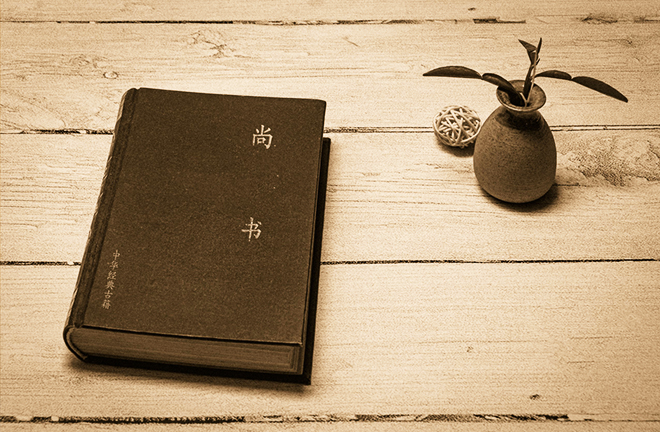Chinese literature goes global from a multimodal perspective

The Book of Documents is one of the Five Classics of ancient Chinese literature. Photo: TUCHONG
In the era of new media, various modalities such as text, images, audios, and videos converge, and the internet, new media and mobile devices have penetrated our lives deeply. Short videos and self-media have risen rapidly, fundamentally altering the linguistic landscape and communication modes of human society. Analyzing how these multimodalities reshape the ecology of literary creation and dissemination from the perspectives of language, culture, and communication holds immense significance for the global dissemination of Chinese literature.
Multimodal symbols expand the space of meaning generation, narrow the cultural gap, and reduce psychological distance. According to multimodal theories, non-literal and literal symbols complement each other, which can maximize readers’ perceptions, improve information transmission effectiveness, and enrich readers’ reading experience. If a literary work adeptly employs multimodal symbols, it can fully activate the perceptual understanding of the audience, effectively convey spatial and emotional significance, communicate aesthetic value, boost appeal and persuasion, and imbue the literary work with vividness and depth of feeling.
The going global of Chinese literature involves more than mere translation into foreign languages. Apart from linguistic disparities, Chinese literature translation must grapple with the psychological distance between Chinese and foreign audiences concerning aspects such as time, space, society, and culture.
Multimodal symbols, in contrast to high-context textual symbols, rely more on sensory cognition and are comparatively less reliant on language and cultural contexts. Multimedia products like images, audios, and videos are often succinct, self-contained. Furthermore, those media products convey meaning efficiently.
Multimedia enhances the effectiveness of literary dissemination, presenting both opportunities and challenges. The widespread use of the internet, new media, and mobile devices has altered the pathways of literary dissemination to a certain extent. Literary communication no longer relies solely on print medium. Instead, audio media, visual media, and social network media have gradually become the main channels for the dissemination of literary products. The global audiobook market is growing rapidly, with a noticeable trend towards a younger audience. The dissemination of literary derivatives is gaining momentum. Film and television adaptations of literary works can quickly become popular on social networks. New media such as short videos and self-media not only improve the efficiency of literary product dissemination, but also diversify the forms of literary product dissemination.
In the era of new media, literature creation and dissemination encounter both new opportunities and challenges. On one hand, the rise of social media and short videos has transformed people’s reading habits, leading to a preference for content akin to film and television products and thereby intensifying competition within the realm of literary consumption. On the other hand, the process of adapting literary creation to fit the demands of the new media era presents its own set of challenges.
We should correctly view the opportunities and challenges facing literary creation from the perspective of development. Multimodal symbols offer unparalleled advantages in meaning expression, and the emergence of a multimodal language landscape is a historical inevitability, reflecting the development of society, economy, culture and technology to a certain stage. Literary creation and dissemination should also keep pace with the times and develop continuously. Adapting to the multimodal language landscape represents the future direction of literature creation and dissemination in the future.
Opportunities and challenges often possess the potential for mutual transformation. Multimedia technology furnishes literary creation and dissemination with multimodal symbols, expanding the repertoire of meaning expression and bolstering cultural products like short videos. At present, the greatest opportunity for the global dissemination of Chinese literature lies in the great rejuvenation of the Chinese nation. The key to the translation and dissemination of Chinese literature is to grasp the conditions for the mutual transformation of opportunities and challenges.
The translation of Chinese literature should not only adapt to the multimodal language landscape, but also acknowledge the shortcomings of multimodal communication, considering factors like speed, scope and depth of transmission. It is suggested to leverage the traffic-attracting capabilities of new media, increasing transmission speed, broadening coverage, boosting topic popularity, and attracting potential audiences. Utilizing multimedia technology to create film and television adaptations and cultural derivatives based on literary works can cultivate the target audience in a concise, vivid and straightforward way. Creating audiobooks to guide the audience to appreciate the original literature works is also advisable, along with using social media to engage the public and guide discussions.
Multimodality provides a fresh approach and perspective for the global dissemination of Chinese literature. The key to cultural communication is the establishment of cultural identity and the cultivation of cultural appeal through emotional resonance and aesthetic convergence. With its profound heritage and wealth of rich materials, Chinese literature relies on the new media form offered by multimodality to convey emotional experiences imbued with aesthetic value. This effectively enhances the affinity, appeal and allure of Chinese culture through emotional resonance. Multimodality provides a solid material and technical foundation for Chinese literature to cope with the evolving times. The array of new symbolic resources and media provide a broad space for the creation, translation and dissemination of Chinese literature.
Man Deliang is a lecturer from the School of Interpreting and Translation Studies at Guangdong University of Foreign Studies.
Edited by ZHAO YUAN
